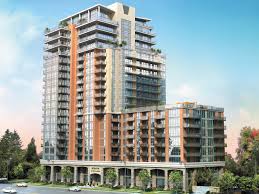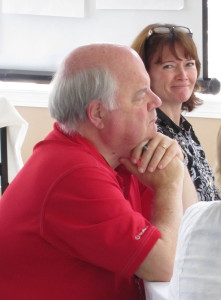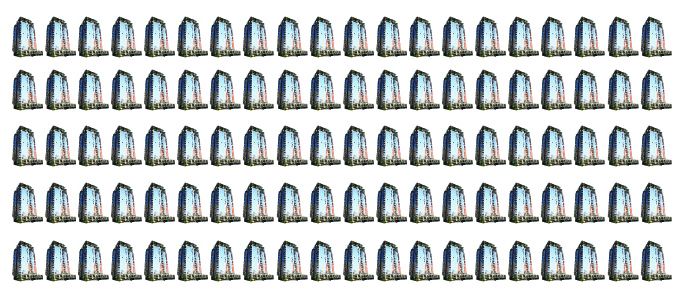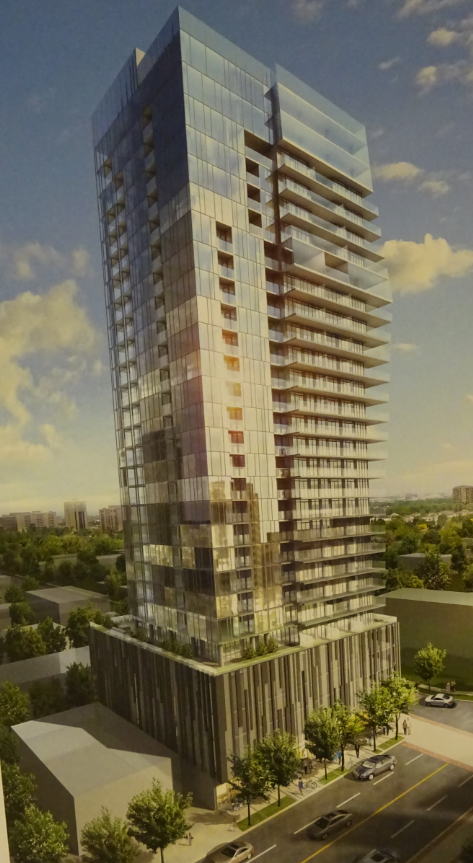 By Pepper Parr
By Pepper Parr
August 5, 2015
BURLINGTON, ON
What would Burlington look like with 100 Strata’s built around the city?

This is what the Strata looks like. Councillor John Taylor thinks the city is going to need 100 of these in the next 25 years to meet the intensification target set by the province.
What’s a Strata? That’s the condominium the Molinaro gropup built on Maple Avenue.
That was the potential ward 3 city Councillor John Taylor tossed on the table during a city council Committee of the whole recently.

John Taylor, Councillor for ward 3 and the Dean of Burlington’s city council
Taylor puts the city’s current population at 175,000 people – the signs as you enter the city say 176,000.
The Growing in Place program – that is a provincial government directive, calls for Burlington to have a population of 195,000 by 2031
That number is thought to rise to 210,000 by 2041. The projection for 2041 number is something that is still being worked out by the Region and the four municipalities in Halton.
We can quibble all we want but the bald fact is that between now and 2041 the city is expected to add 35,000 people to the population total.
And because there is no development north of the Hwy 5 – 407 line – all those people have to be tucked in south of that line
Taylor says his math works like this.
Assume the 35,000 number for 2041 is real – assume two people per unit that means we need 17,500 housing units.
The Strata has 175 units – add two 0’s to that number and you have what is needed

Are 100 Strata’s really needed to reach the intensification target. Where would they get built> The Strategic Plan and the review of the Official Plan are the documents that will guide and inform these decisions – but they may not see the light of day in their final form until sometime next year.
Therefore Taylor points out you are going to need 100 Strata’s to house those 35,000 people.
And that is going to put intolerable pressure on the city’s transportation network.
Those cold hard facts are also why the ADI Development Group bought up the land at Masonry Court in the west end – they will do exceptionally well with that project financially. And they will have little difficulty getting the approvals they need – if city council doesn’t approve the project – off ADI will go to the OMB. That is what they are doing with the 28 storey structure they want to build at Martha and Lakeshore Road.

The ADI development planned for the corner of Martha and Lakeshore Road will help meet the intensification target – what would it do to traffic and the look and feel of the downtown core if the Ontario Municipal Board approves the project.
The city is battling on two fronts – dancing with developers who point out that the housing has to be built and we have just the project for you.
While the transportation people point out that the infrastructure we have in place now cannot handle the traffic those 35,000 people will create.
It’s a tough one, especially for a city council that is one – not united on how to handle this problem and two; a council that has never been transit friendly.
Add to that a city that still doesn’t understand how to communicate with its citizens.
The Mayor is reported to be thinking in terms of a population growth of from 1% to 1.5% population growth. The Mayor hasn’t been available for comment on these number. He has been softening up the public for the intensification that is inevitable.
There is a lot for the public to think about – but before they can think through the issues and arrive at conclusions – they need facts from the city.
Seen any facts from the city on these problems lately?



















Burlington must not sprawl out to accommodate growth. We’d loose too much agricultural land and nature areas which clean our air and water. Burlington’s section of the Niagara Escarpment is mostly in a natural state and should be considered a precious family heirloom worthy of preservation for future generations.
Urban growth need not lead to increased grid lock, stress and unlivable cities. Admittedly, those steel and glass boxes look boringly institutional. I’m pretty sure Burlington can do much better.
High density urban development can be intelligent, thoughtful, creative, inspired, energy efficient and low environmental impact.
Smart Growth
https://en.wikipedia.org/wiki/Smart_growth
High population density nodes with efficient access to transportation hubs conserve energy, improve public transportation efficiency, reduce commute times AND the per person environmental foot print.
Concentrating many people in a small area leads to increased food and entertainment services availability.
Smart growth could increase choices regarding renovations, subletting and property ownership.
Some neighborhoods could be rezoned to allow 3rd or 4th floors or sale of space above a residence or commercial property.
Rather than your children moving out, Smart Growth might mean adding a floor or two to your home to accommodate multi-generational homes. http://www.japantimes.co.jp/community/2014/06/02/how-tos/generation-gaps-filled-brick-mortar
Burlington’s 3 GO Train Stations are under utilized and could accommodate very intense development with adding significantly to grid lock. The largest buildings in Burlington, should be connected by a short walkway to our GO train stations.
Fairview St., Plains and Harvester Rd. connect these GO Stations. These underutilized thoroughfares could also accommodate increased growth.
Many options for Burlington’s future exist, except the keeping the status quo. If 35,000 people are moving to Burlington in the next 20 years, then we should plan for it now.
100 Strata condos makes it seem like we’re going to see dramatic growth here in Burlington, but it’s really not.
Based on these projections, Burlington will be the slowest-growing city in the entire GTA, and growing considerably more slowly than in the 5 years leading up to the last census where our population grew by over 11,000.
If we are to grow by 35,000 people or 20% over the next 25 years, it need not be intolerable. But we’ll need to rely on many different solutions to maintain that mobility instead of just one. To keep the number of automobile trips constant (which means maintaining the same level of service for people who drive as we enjoy today – with ZERO new car lane capacity required), we will need to shift from 77% to 64% the percentage of trips taken by automobile drivers. This can be accomplished a number of ways. Here is a realistic example.
– shifting the percentage of trips taken on foot from 3% to 5%. (mostly downtown and by locating intensification near destinations – mobility hubs and shopping plazas)
– shifting the percentage of trips taken by bicycle from less than 1% to 5% (building a bike network that allows safe/comfortable bike transport to destinations <10km away).
– shifting the percentage of trips taken by automobile passengers from 17% to 19% (carpooling/taxis/Uber/TDM).
– shifting the percentage of trips taken by transit from 2% to 6% (convenient connections to GO with province-wide expansion and higher frequency main routes in the city)
Other strategies may involve improving traffic flow through intelligent signal design, households grouping trips together, enabling flexible workplaces and hubs for telecommuting.
The demographic shift will also mean that a greater proportion of us will be retired – Maybe we just won't need to make quite so many trips at the peak time.
Again this shift is long-term – it will take place gradually over the course of 25 years. But we need to start putting in place the infrastructure to make it happen now. City Council is willing to raise our taxes to fund road repairs – they just voted to add another $20 million to the pot. What if they did the same to advance the Cycling Master Plan? What if they did the same towards a credible Transit Master Plan? Our quality of life can remain high if we stop the political bickering and get on with the work of building for the future.
Chris, the problem is that the growth has to be concentrated in certain places. It was sprawl in the past, with larger numbers, but now the growth has to be considered and assessed in the new context, which is a much smaller available space.
The 100 Strata condos won’t be spread all over Burlington, or at the fringes of sprawl, but rather concentrated in the limited spaces that are now available.
Burlington is half rural/agricultural, which will get little of the growth, and the other half is urban, where most people live, and that is approaching build-out. Therefore, the growth is being proposed in the urban intensification theme, with general densities proposed to be much higher than Burlington has generally experienced.
Therefore, even with lower numbers, taking the intensification area space as context, the growth and density will definitely appear to be dramatic. Just take the ADI Martha St proposal for 28 stories as a vivid example.
Growth rates cannot be judged as “dramatic”, or not, without looking at the context it takes place in, then the scale has to be considered, and whether that scale is appropriate. Whether it’s tolerable or not depends on whether you have to live next door, and also your point of view.
The quantitative solutions you propose, particularly the various modes that might split the total trip counts, look like they came from a spread sheet model that assumes the shifts between modes can be treated like ordinary arithmetic.
Implicit in this model is an assumption that the arithmetic takes place in a flat or linear space, without any hills or valleys that make things curved.
The trouble is, the modal or other solutions selections, by real humans is highly non-linear, with some shifts facing hills or mountains, and others susceptible to slipping into valleys.
Like shifting trips from cars to transit, or to bikes or to walking, faces mountains, whereas, going the other way, or sliding back, seems to be subject to valleys. In many cases, moving from cars or vehicles and roads is impossible. This results from problems of scale.
All of the solutions face this non-linear mapping of trip mode selection by real people. These selections are process driven and decidedly functional and complex.
You can’t just expect that real humans will simply move from one solution to another, behaving like your model. There is a saying that reflects this reality – “the map is not the terrain.”
Some of the things you mention are already happening, and can continue to move us in a positive direction. But I agree with your points that we need political will and spending priority to get anywhere near to where you point. This will take money to create a tolerable future.
Without these things, which people are entitled to expect from our politicians, we cannot get there from here.
You’re absolutely right that density will be viewed in the eye of the beholder. However that shouldn’t stop us from planning where and how that density affects us. Otherwise developers like ADI and the OMB will be doing the planning for us.
A good plan or “map” requires quantification – you seemed to suggest that yourself on another thread. I’ve made an attempt at doing that. Abstracting the issue to “adding another 100 Strata condos” does little to tell us how the density will impact people – all it does is stir up people’s fears.
People respond to incentives. The individual decisions about which mode of travel to use for a given trip don’t neatly fit into a model, but they do reflect changes in society and in the built environment. Everywhere in North America where additional capacity was built for motor vehicles, it shouldn’t surprise anyone that we ended up with more cars on the roads. Where capacity was built for bicycles, such as in Vancouver or Portland (or even more recently Toronto), we got more bicycles. If transit is more convenient and goes to the places people want to go on a frequent and reliable schedule, more people will decide to take transit.
All of the changes I’ve outlined are at the margins. Those most predisposed to making changes will change. The bulk of the population who are most entrenched in their current patterns will not change. Yet in total, the extra growth does not have to add materially to our traffic loads. Of course specific locations will be impacted differently from others and the locations are important. The details I’ve seen from the city focus on the GO stations, Downtown, the Fairview/Plains corridor and other underutilized properties such as strip plazas and surface parking lots.
There’s enough space available and potential to evolve the city’s transportation network over the long-term that we don’t have to spread fears that the homes next door are going to be turned into Strata-sized condominiums, and all those people are going be in our way when we drive to work in the morning.
In planning, “Density” is an objective quantity that is independent of the beholder – it is units per hectare, or less exact, people or jobs per hectare.
It is not abstract as you say. This quantity is exactly how Councillor Taylor calculated the number of Stratas, which have a known density, it would take to hold the example 35,000 people Burlington is supposed to accommodate as intensification.
This is a real possible reality, that gives an example of what the additional people might involve in built form. If it stirs up fears, that’s a complementary reality. It is based on a concrete impression of possible density approvals, and this could impact people concretely.
What you quantified, or tried to, does not have this proportional, straight line arithmetic property, as I described above previously. It is not based on objective, independent quantities. It’s you that are abstracting the issue with your naïve trip mode selection spread sheet. You seem to make it sound like everything will work out fine so don’t worry, people will change. I have a problem with this.
In fact, what I see in this amounts to people being forced to accept the 100 Stratas, or an equivalent, and also forced to accept the consequences of the results.
Yes, people can change, and marginal changes are happening, but significant change must be made possible, or you are just misleading people.
The eyes of people, the “beholder”, view density qualitatively, through their values, preferences, how it affects them, whether they stand to profit through vested interests, or political ambition, and so on. Transportation impacts are a very important consideration.
I don’t see a real, assessable plan to keep traffic loads not increased materially, as you say. Other than the Strata example, I don’t see any quantification of where all this built space will be or can go, illustrated in consistent and arithmetic totals and allocations.
Your examples are again no different in concrete and helpful analysis than hopes and prayers and assumptions of baseless optimism (did you read my thread to the July 31 story we commented on?). All the bad things we want to avoid are the default end points of the path we are on. On second thought, we have already arrived where we don’t want to be.
We need to spread fears about where we, the people, are headed, and ask what the politicians are going to do about it (beside tell us to lump it).
Being “The Dean” of a dysfunctional and divided (as well as divisive) Council isn’t exactly an honour for Taylor. Indeed, this group is singularly ill-equipped to deal with the major intensification and infrastructure issues facing the city. But we voted them ALL back in so who’s really to blame?